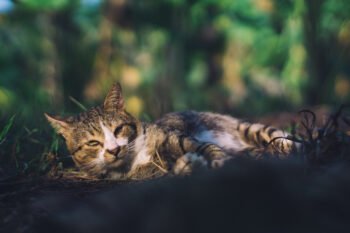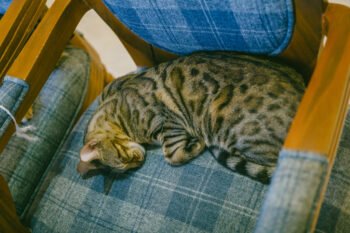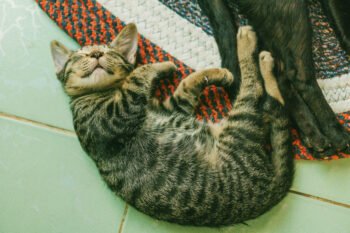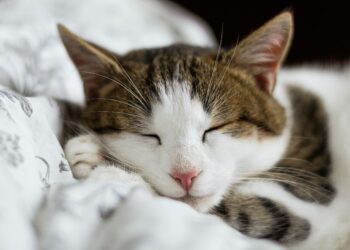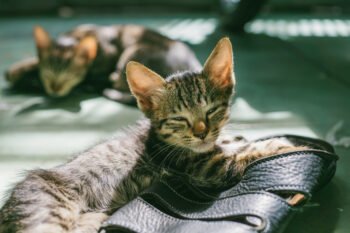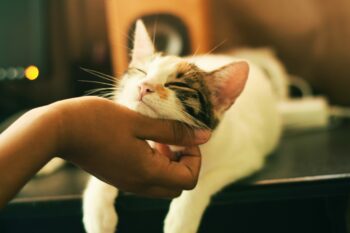You take in a stray cat and have simply been too busy to schedule an appointment to have her spayed. Then one day you come home to find her howling constantly and rolling around on the floor. Has she gone mad? No, she’s gone into heat, or estrus.
The reproductive cycle of female cats is different from that of women or dogs. Women have a monthly a menstrual cycle, during which the ovaries produce a viable egg and then, if fertilization does not occur, the uterus sheds a discharge. There is no specific period of receptivity to mating (and its opposite, a lack of receptivity) among humans-although certainly, there are times when we feel more romantic!
Cats and dogs, on the other hand, have an estrous cycle, during which the ovary is primed to produce an egg and the female is specifically receptive to mating. The estrous cycle consists of estrus, the period of mating, preceded by proestrus and followed by metestrus. During the breeding season, one estrus cycle is separated from the next by a brief inactive period known as diestrus. The longer quiescent period during the remainder of the year is called anestrus (literally “no estrus”).
Intact female cats, called queens, reach sexual maturity at about seven to nine months. The age of sexual maturity varies with individuals as well as with breed–Persian cats, for example, tend to experience their first estrus much later.
Do Cats Have a Breeding Season?
In most cases, yes! Unlike dogs, for whom estrus occurs approximately every six months, female cats go into heat several times during a single, prolonged breeding season. The breeding season is controlled by the number of hours of daylight (the same is true of horses). In the Northern Hemisphere, the feline breeding season lasts roughly from February to September. Many cats (not all) will stop their estrus cycles (go into anestrus) in the fall and early winter, when there are fewer daylight hours. It is interesting to note, however, that indoor cats may cycle throughout the year because electric lights give them about the same light/dark cycle throughout the four seasons.
Behavior Changes During the Estrous Cycle
Female cats exhibit dramatic changes in behavior while they are in estrus. Owners–often unsure about the reason for these changes–notice increased affection, purring, and rubbing. The cats will roll from side to side and meow or yowl much more than they typically do-a lot more! At the peak of estrus, when the female actively invites the male, she may lie with chest and forelegs down on the ground, her hind legs stretching upwards and treading-inviting a mate. These behavior changes can be so striking that unknowing human companions may become alarmed and call the veterinarian to report a mysterious illness!
How Long Does the Estrous Cycle Last?
One entire heat or estrous cycle, which consists of estrus and diestrus together, lasts roughly from 18 to 24 days. Estrus itself, the phase in which cats act a little crazy and are receptive to being mated, lasts approximately four to 10 days. If not mated or spayed, a female cat will continually cycle into and out of estrus during the entire breeding season. This is not especially good for a cat’s health, as the physical demands of estrus can be quite upsetting. It’s not so good for your sanity, either!
Induced Ovulators
Like rabbits, cats are induced ovulators. Although they go into heat they do not actually ovulate, or release eggs from the ovary, unless they have sex. Once mating occurs, eggs are released, and fertilization takes place approximately 24 hours later. If the mating is unsuccessful, the female will not cycle back into estrus for 36 days (a period called pseudopregnancy). In fact, some veterinarians and breeders will purposely induce pseudopregnancy in order to delay the return of estrus. If a queen does become pregnant, of course, she will not continue to cycle until the kittens have been born and then weaned.
Is My Cat Pregnant?
Whether you have purposefully bred your purebred cat, or are faced with a not-yet-spayed young pet who (you suspect) has had a tryst with the neighborhood tom, you may wonder just how to tell if she is pregnant. Cats are notoriously stoic animals who reveal little information about physical changes. In fact, many cat owners have no suspicion of their pet’s pregnancy until the day a litter of kittens is discovered in the laundry hamper.
One of the earliest indications of pregnancy is the “pinking up” of nipples, which change from a pale pink to a deeper reddish shade, and appear more prominent. Pinking in most cats tends to appear two to three weeks into pregnancy. However, some cats will not show this change until later, even up to the time of delivery.
Changes invisible to an untrained (but concerned) cat lover may be detectable by a veterinarian, who can gently palpate (feel) fetuses by 17 to 25 days. An ultrasound examination can detect fetal heartbeats by the 26th day of pregnancy. Less expensive for those who need confirmation is a simple X-ray which, by day 45, will reveal the skeletons of growing kittens.
At some point toward the end of gestation, approximately 2 weeks before the birth of kittens, milk may be present in the mammary glands. Some cats, however, may not have evidence of milk until the kittens are actually born).
In many cases, the only sign of pregnancy may be a change in your pet’s behavior. Pregnant females often tend to rub against their owners, knead their paws and purr more than usual–not unlike the behavior changes seen during estrus.
How long does pregnancy last?
The average length of gestation in cats is 66 days, but it can be as short as 58 days or as long as 71 days. While individuals vary, each cat tends to be consistent from one pregnancy to another.
If you suspect that your cat is pregnant, be sure to provide a well-balanced and complete diet in amounts recommended on the label for pregnant cats. Although expecting moms will eat more, it is best to avoid overfeeding your cat. If you are unsure about weight gain and amounts of food to offer, monitor your cat’s weight and call the veterinarian. In any case, make at least one pre-natal appointment for your cat. Your vet can also advise you about what to feed a nursing mom and how to help her care for her kittens. When possible, it is advisable to avoid supplements or medications (including herbal products) and vaccinations, and to follow a veterinarian’s advice before giving your cat anything other than food.

